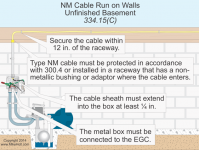LarryFine
Master Electrician Electric Contractor Richmond VA
- Location
- Henrico County, VA
- Occupation
- Electrical Contractor
So, leave the sheath on if you prefer. I'm certainly not saying that you may not have the sheaths 1/4" in.So why isn't that a violation of 310.120(A)? Otherwise, I agree that the NM to conduit transition fitting, along with stripping the NM sheath, would be a change in wiring method, and so the 312.5(C) becomes moot, as a cable is no longer entering the cabinet.
In my opinion, as individual conductors in a conduit and no longer in a cable, it need not be so secured.If you don't strip the NM sheath, there's no 310.120(A) issue. But I think if the switchover clamp connector is far enough away from the cabinet, it's hard to argue that the cable is secured to the cabinet.
As with almost all NM installations, the sheath is secured where it enters the cable clamp, wherever it is.

